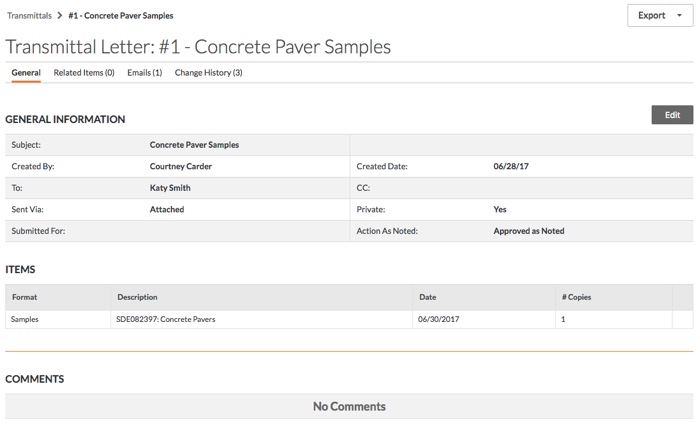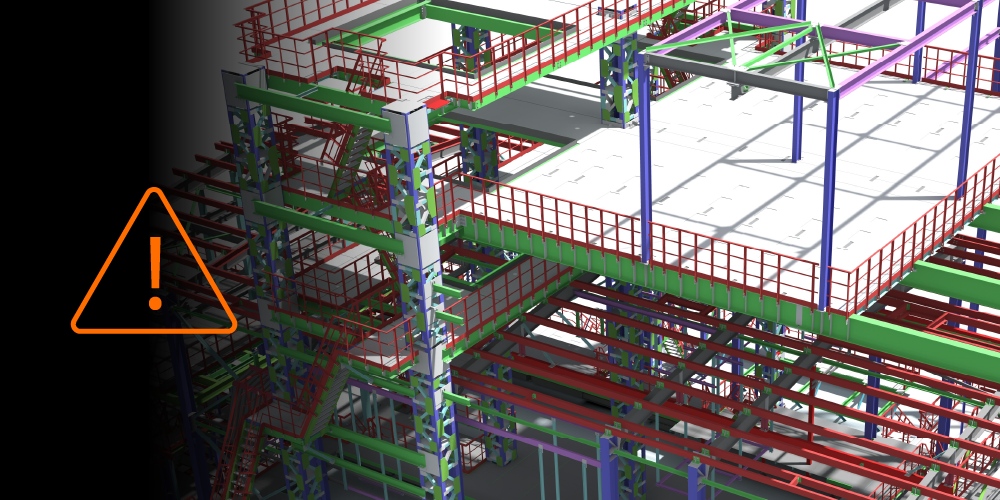Related Articles
— 7 min read
What Are Transmittals in Construction? Why They Matter and How to Use Them

Last Updated Aug 28, 2025

Josh Krissansen
48 articles
Josh Krissansen is a freelance writer with two years of experience contributing to Procore's educational library. He specialises in transforming complex construction concepts into clear, actionable insights for professionals in the industry.
Last Updated Aug 28, 2025

Without clear documentation, managing “complex” commercial projects can quickly spiral into resources wasted putting out fires brought on by chaos and confusion.
On an already multifaceted and cross-functional construction project, those are the last things you need. And that’s precisely why transmittals matter: they’re so much more than mere documents because they do much more.
Transmittals support clarity and cohesion, even at scale, by providing a formal record of information exchanges that would otherwise be difficult to track. When documents are sent via fax, courier, or other non-digital methods, transmittals ensure those exchanges remain visible, traceable, and contractually sound.
In this article, we’ll explore the nature of transmittals in the context of development projects, why they matter to the success of these large-scale commercial builds, and how to use them effectively across construction workflows.
Table of contents
What is a Transmittal?
As a formal document used to track the distribution of key project information, transmittals record:
What was sent; To whom; When; How; Why
With the essentials logged upfront, it’s easy to see why the outcome they consistently enable is a team’s ability to create a clear audit trail — key for both accountability and, if the need arises, dispute resolution.
When information such as drawings, contracts and their variations, or RFIs and responses are sent physically, through shipping channels or via fax, transmittals function as a cover sheet that summarises the delivery details and clarifies the purpose of the exchange.
Here’s a common example: When sending updated shop drawings to a consultant, along with a response deadline, a contractor would use a transmittal to document the information transfer formally.
Transmittals are especially valuable for:
- Maintaining an audit trail for compliance and dispute resolution
- Ensuring the right people receive the correct documents
- Clarifying the purpose and required action for shared documents

Transmittal vs. Submittal
A quick note on transmittals vs submittals: though they’re often used together, the two are not interchangeable.
A submittal is a formal package that typically requires review or approval, while a transmittal documents the act of sending project materials, such as drawings or contracts.
Think of it this way:
- Transmittals help teams track communication.
- Submittals help teams manage decision-making.
Purpose and Importance of Transmittals
Transmittals ensure that project documents are distributed in a formal, trackable format.
Each transmittal captures the sender, recipient, delivery method, and date, creating a structured record of communication that supports both project progress and contractual obligations. They serve three core functions:
1. Formal Delivery
When email or digital methods are unavailable, transmittals allow standardised document sharing and information capture because all parties share conventions.
As official cover sheets for drawings, RFIs, contracts, and other key items, you can use them to ensure every exchange is properly recorded and, more importantly, that the information conveyed is understood by everyone equally.
2. Record Keeping and Accountability
Transmittals create a time-stamped record of document exchanges, supporting compliance and helping resolve disputes.
Within modern construction management platforms, transmittals are often automatically stored and linked to related items, making change history accessible when needed.
3. Clear Communication
Transmittals clarify intent by stating the purpose and required action, such as review, approval, or follow-up.
Detailed notes and structured fields reduce ambiguity and help align stakeholders around a central, reliable source of project information.
Key Components of a Transmittal Document
An effective transmittal includes several key fields that support traceability, clarity, and version control.
Document list
- Lists all documents being transmitted
- Files must be final before attachment, as they cannot be edited after submission
Sender & recipient information
- Full names, company affiliations, and contact details for sender and recipient
- 'To' and 'CC' fields to ensure relevant stakeholders are included
Date of transmittal
- Records the creation and distribution date
- Establishes a time-stamped record that supports audits and alignment across teams
Project reference
- Identifies the relevant project by name or number
- Helps link the transmittal to the correct contract, scope of work, or work package
Revision number or date
- Indicates the version of each attached document
- Prevents confusion and helps recipients confirm they are working from the most current information
Required instructions or actions
- Specifies the purpose e.g. review, approval, or information only
- Outlines the expected action, such as return, signoff, or resubmit
Pro Tip
Teams can improve consistency and reduce errors by applying a few best practices:
- Use clear, descriptive subject lines
- Provide context or instructions in the comments field
- Apply company branding to the transmittal format
- Mark transmittals as private when distributing sensitive material
- Export completed records to PDF or CSV for external use
- Reference change history or related items to maintain accountability across workflows
Benefits of Using Transmittals
Used correctly, transmittals do more than document exchanges. They improve day-to-day operations, reduce risk, and support long-term project outcomes. The benefits span communication, coordination, compliance, and control.
Improved Communication
Structured document sharing reduces confusion. Transmittals clarify who received what, when, and why, keeping stakeholders aligned.
Fewer Errors, Less Rework
Mistakes often stem from missing context or outdated documents. Transmittals minimise both.
Each submission includes a reason, a required action, and a timestamped record of the version sent. That clarity prevents avoidable rework and keeps teams focused on current information.
More Efficient Project Management
Transmittals centralise document handling. Instead of relying on scattered email threads or disconnected folders, teams can retrieve records quickly, monitor communication history, and keep workflows moving without added administrative effort. Export functions support integration with reporting processes when needed.
Better Support for Dispute Resolution
When conflicts arise, evidence matters. Transmittals create a verified distribution record, detailing who sent what, to whom, when, and how. That history supports contractual enforcement, protects against claims, and helps resolve issues efficiently.
Centralised Control Over Project Documents
Keeping all transmittals in one place prevents files from getting lost across tools. Access can be restricted where appropriate.
Clearer Expectations for the Next Steps
Each transmittal specifies the submission's reason and what the recipient needs to do. This eliminates guesswork and shortens response times. When used consistently, these fields help teams move faster and reduce back-and-forth.
Professional, Custom-Branded Communication
Templates, including letterheads and formatting standards, can be tailored to reflect company branding. This promotes consistency across formal communications and reinforces professionalism in every document exchange.
Common Uses and Examples in Construction
Transmittals are used to formally distribute and track a wide range of project documents, including:
- Drawings and plans: Share construction plans, prints, and shop drawings for review or approval
- Specifications and contracts: Send technical specifications, subcontracts, change orders, and purchase order contracts
- RFIs: Record the formal submission and tracking of RFIs requiring clarification
- Meeting minutes and updates: Distribute meeting notes or site updates to relevant stakeholders
- Submittals: Deliver submittal log items or packages for formal review and response
- Defect list items: Communicate final tasks or corrections ahead of project closeout
- General project documents: Attach samples, attic stock, or other materials requiring distribution and traceability
The Shift to Digital Transmittals
Digital transmittals are now standard practice across mid to large construction and engineering firms. While some smaller contractors still rely on email or manual processes, digital systems are fast becoming the norm.
This shift reflects broader industry trends. According to Deloitte, the average Australian construction business now uses 20% more software tools than it did the previous year.
As digital adoption accelerates, transmittals are increasingly integrated into broader document workflows, helping businesses access:
Greater Efficiency and Automation
Digital workflows eliminate the need for printing, scanning, and manual follow-up. Automated notifications, version control, and digital signoff reduce administrative effort and help teams avoid delays or oversights.
Improved Visibility and Audit Control
Every transmittal, including sender, recipient, dates, and attachments, is automatically tracked. This creates a reliable project record that supports compliance and simplifies dispute resolution. Centralised storage also reduces the risk of lost or misfiled documents.
Faster Communication and Collaboration
Real-time sharing keeps teams aligned and ensures everyone works from the most current version of each document. Transmittals remove reliance on disconnected channels like email or text and support a more structured and transparent communication flow.
Broader Document Coverage
Modern platforms allow teams to attach a wide range of project records. This centralises distribution and supports regulatory moves toward digital documentation.
Smarter Decision-Making
Digital transmittals capture structured project data that can be used to monitor performance, identify trends, and refine planning. Combined with other construction tools, they support a more proactive, data-driven approach to project management.
Transmittals are essential for controlling document flow in commercial construction projects.
Transmittals are formal documents used in construction to track and manage critical project information exchanges, supporting clarity, accountability, and compliance. Consistent use of transmittals improves communication, reduces errors, streamlines workflows, and simplifies dispute resolution.
Categories:
Written by

Josh Krissansen
48 articles
Josh Krissansen is a freelance writer with two years of experience contributing to Procore's educational library. He specialises in transforming complex construction concepts into clear, actionable insights for professionals in the industry.
View profileExplore more helpful resources

Managing Direct Costs in Construction: How Visibility Drives Profitability
Direct costs define the financial reality of every construction project. They cover the labour, materials, and equipment that drive delivery and determine profitability. But even the best-planned budgets can shift...

BIM Clash Detection: Reducing Rework, Delays, and Risk in Construction
Design clashes can be a significant hidden cost in construction, as each conflict between systems risks expensive rework, project delays, and reduced margins. BIM clash detection empowers teams to identify...

Next-Gen Job-Costing: Ready to Move? 5 Things to Consider Before You Get Started
In this three-part series, Quantity Surveyor turned Financial Solutions Specialist Clint Burgess uncovers the real-world gains for people, processes, and profits when businesses move from legacy to next-generation Enterprise Resource...

From Workarounds to Workflow: Solving Construction’s Legacy Job-Costing System Challenges with Next-Gen Tools
In this three-part series, Quantity Surveyor turned Financial Solutions Specialist Clint Burgess uncovers the real-world gains for people, processes, and profits when businesses move from legacy to next-generation Enterprise Resource...
